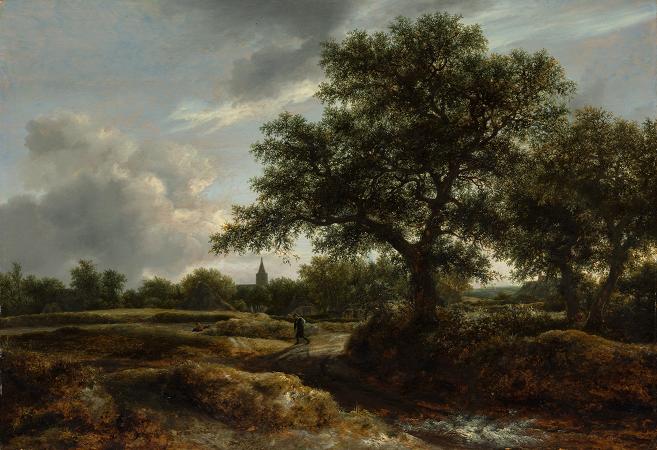Meindert Hobbema (1638 - 1709). Meindert Hobbema was a Dutch Golden Age painter of landscapes, specializing in views of woodland, although his most famous painting, The Avenue at Middelharnis, shows a different type of scene. Hobbema was a pupil of Jacob van Ruisdael, the pre-eminent landscape painter of the Dutch Golden Age, and in his mature period produced paintings developing one aspect of his master's more varied output, specializing in sunny forest scenes opened by roads and glistening ponds, fairly flat landscapes with scattered tree groups, and water mills, including over 30 of the last in paintings. The majority of his mature works come from the 1660s; after he married and took a job as an exciseman in 1668 he painted less, and after 1689 apparently not at all. He was not very well known in his lifetime or for nearly a century after his death, but became steadily more popular from the last decades of the 18th century until the 20th century. Hobbema was born and died in Amsterdam. The son of a carpenter named Lubbert Meyndertsz, he adopted his grandmother´s surname Hobbema quite early on, although it is not known why. He spent a period in an orphanage from 1653, but by about two years later he had left, and soon became the only documented pupil of the leading Amsterdam landscapist, Jacob van Ruisdael, whose influence was to dominate his work. Jan van Kessel may also have been a pupil of Ruisdael; he was close to Hobbema, who was godfather to his child in 1675. Hobbema's signed pictures come from 1658 to 1689. For a considerable period it was profitable to pass off Hobbemas as Ruisdaels, and Hobbema's name was probably removed from several of his works. Hobbema seems to have painted the figures on a number of Ruisdael's paintings; they were recognised as a weakness of the master. They may have travelled together a short way across the German border in 1661, via the Veluwe, Deventer and Ootmarsum. Hobbema married at the age of thirty, to Eeltje Vinck from Gorcum, a maidservant to the burgomaster Lambert Reynst, at this point an important political figure in the republican Dutch States Party as brother-in-law to the De Graeff brothers. She was four years older than him. The wedding was in the Oude Kerk at Amsterdam, on 2 November 1668. Witnesses to the marriage were the bride's brother Cornelius Vinck and Jacob van Ruisdael. The couple had five children. In 1704 Eeltje died, and was buried in the paupers' section of the Leiden cemetery at Amsterdam. Hobbema himself survived till December 1709, and was buried on the 14th of that month in the paupers' section of the Westerkerk cemetery at Amsterdam. Also in 1668, and presumably through the connection with his wife's ex-employer, he took the well-paid position of wine-gauger for the Amsterdam octroi, assessing and collecting local taxes on wine, holding this until his death. It is clear that his painting greatly reduced after this, but it did not end completely, as used to be thought. The quality of his work becomes uneven, though there are very successful late works, including The Avenue at Middelharnis, dated 1689 and one of his last paintings. After 1672 the Dutch art market virtually collapsed for the rest of the century, and other artists of his approximate generation produced much less, including Johannes Vermeer, Pieter de Hooch and Nicolaes Berchem. The Hobbema family lived in the Rozengracht in the Jordaan neighbourhood, as had Rembrandt in his later and impoverished days, as well as Adam Pynacker, Jacob van Loo, Cornelis Holsteyn and other artists. Rembrandt, Frans Hals, Jacob Ruysdael, and Hobbema all died in relative poverty, after they had fallen from fashion, and in Hobbema's case after the Dutch art market had largely collapsed. Hobbema and Ruisdael together represent the final development of Golden Age Dutch landscape art; by the end of Hobbema's career, demand had severely declined. Despite his apprenticeship with Jacob van Ruysdael, Hobbema's earliest paintings, from the late 1650s, are mostly river scenes more in the style of Cornelis Vroom and Salomon van Ruysdael. From around 1662 the influence of Jacob van Ruysdael becomes much stronger, and Hobbema settled into his speciality of wooded landscapes, very often with ponds, roads, and a building or two. Even within the Dutch painting of his day, where specialization in a particular type of subject-matter had become normal, his concentration on such a specific subject was rather unusual. The remainder of the 1660s, especially up to 1668, produced most of his best works, which increased in size and complexity as he perfected his style. His landscapes are sunnier than the equivalent scenes by Jacob van Ruysdael, with the principal trees typically seen with sky behind.
more...














